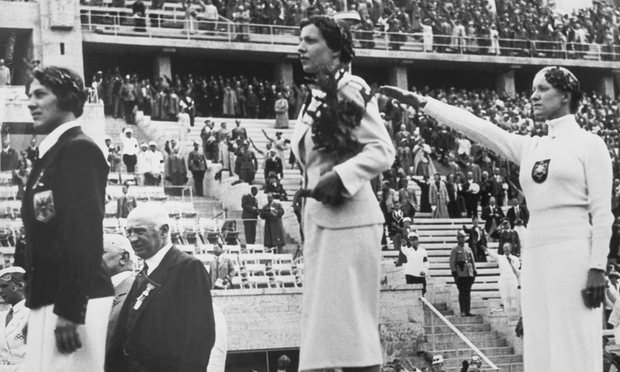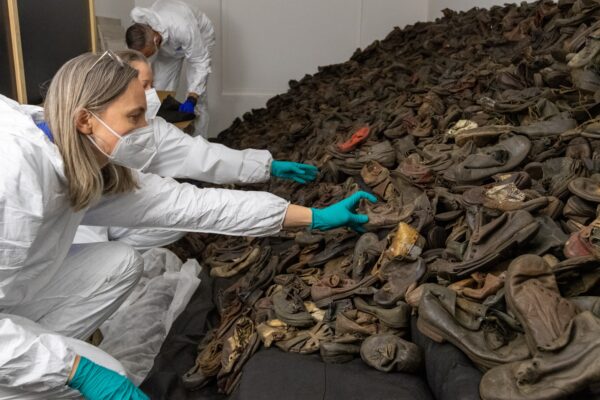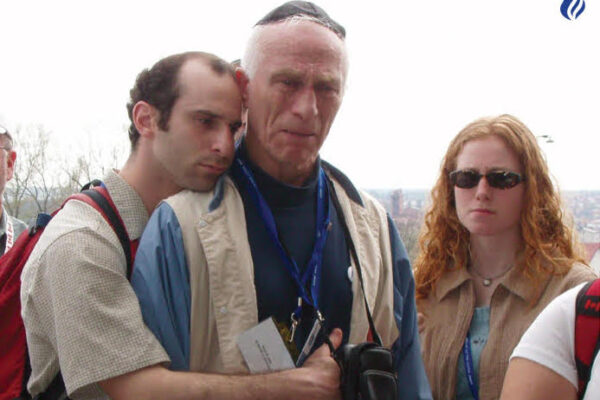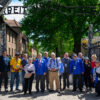
The photograph is at once both beautiful and revolting. Snapped in the fading sun of an August afternoon during the 1936 Olympics in Berlin, this picture is of a German woman standing regal on the medal stand, dressed in white, her posture perfect, her face locked in the stoic gaze of determination. Her arm is outstretched in a strong, certain Nazi salute.
Almost 80 years to the day the photo was taken the woman, Helene Mayer, remains one of the Olympics’ great mysteries. She was, by definition of German law at the time, part-Jewish, which had cost her most of her citizenship rights. Her country’s press was forbidden to mention her name. Once she had been one of Germany’s most beloved athletes, but by that afternoon she had been living a four-year exile in the US, unwanted by her homeland. So why did she throw out her arm in tacit acceptance of so much hate?
The simplest answer is that she had no choice but to give the Nazi salute that day. For a German athlete, the thrusting of her arm on the medal stand was a non-negotiable requirement of the state. Failure to do so would have led to serious repercussions. But the bigger question, the one that has vexed historians, biographers and holocaust experts for eight decades, is why she was there. Was she naive? Was she oblivious to the atrocities Adolf Hitler was already committing? Did she know how the world would view her participation on what would become known as the Nazi Games? Did she care? Was she protecting her family? Was she protecting herself?
The reality is complicated Mayer, who died young at 42 did not leave an endless trail of correspondence. She did not live long enough after World War II to give revealing interviews in a modern media world. There are no film clips of her talking about that time. She never wrote a book. Her intentions have been pieced together by a handful of researchers parsing the few letters of hers that exist and pulling answers from a small group of people who knew her. But even those portrayals feel empty; heavy on the glamor of a beautiful fencer who loved her fame, yet light on the substance of who she was and whatever turmoil roiled inside.
“I think she still is a mystery,” says Susan Bachrach who as curator for special exhibitions at the United States Memorial Holocaust Museum has spent years researching Mayer for an exhibit on the 1936 Olympics.
“What do I think of her? In the end, a selfish person,” says New York filmmaker Semyon Pinkhasov who made a documentary about Mayer in 2008 called: What if? The Helene Mayer Story.
There is no way to see her participation for Germany in 1936 as anything but a sham, manipulated by International Olympic Committee officials who ignored the horrors of Hitler’s regime and American Olympic Committee head Avery Brundage who was fending off a surging American movement to boycott the Games. She was the “token Jew” placed on Germany’s team as a public relations facade to fool the world into thinking Jewish people still had rights in Hitler’s Germany. Most historians have rejected the idea she was protecting her mother and brothers in Germany by participating. The general conclusion is that she was no more than an athlete trapped in the single-minded pursuit of her sport who wanted desperately to compete in the Olympics even if she had to do it for Adolf Hitler.
Several years ago, Pinkhasov met Mayer’s sister-in-law Erika Mayer in Germany who told him that Helene, who had already fenced in two Olympics, yearned to be in a third. “She wanted to compete, she wanted to be famous again,” Pinkhasov says Erika Mayer told him. She was so driven to be a star once more she never realized how much her country had changed, that it would never allow her to be beloved once more.
Part of the complexity for Mayer is that she does not seem to have considered herself Jewish. Her father, Ludwig, a respected physician in the Frankfurt suburb Offenbach, was Jewish and active in Jewish organizations, but her mother was not Jewish. Milly Mogulof’s 2002 biography of Mayer, Foiled: Hitler’s Jewish Olympian, suggests Mayer and her bothers Eugen and Ludwig were raised in a secular home. She attended a Christian school though she was excused from religious activities because of her father’s faith. Bachrach says there was a growing culture at the time of mixed Jewish and Christian families who had Christmas trees in their homes and did not identify as Jewish.
As she rose to prominence in a pre-Hilter 1920s Germany religion was almost never discussed. Mogulof’s book says local news accounts sometimes referred to her as the “Jewish Mayer” to distinguish her from a neighbor with the same last name. College professors would occasionally send inquiries to her school asking for a clarification of her religion because the subject had come up in a class discussion. But those too were rare. She was a fencing star, perhaps Germany’s most dazzling athlete at the time, few people gave thought to her religion until many years later. Mostly the country was amazed by her fencing skill.
“When I see footage of her fencing I cant believe what I see,” says Pinkhasov, a Russian immigrant who fenced himself both in the Soviet Union and in the US. “She is a huge talent. She is phenomenal. If she was alive today and between 20 and 30 (years old), she would win the Olympics. She is so talented. It’s hard to believe now how sensitive her hand is. Her technique is spectacular. Her footwork is just how they teach you.”
In 2000, Sports Illustrated named Mayer the greatest fencer of the 20th century. Pinkhasov does not disagree. Mayer, he says, had a speed and grace few fencers have ever possessed.
“There is nobody better than her,” he says. “Maybe some were at her level but nobody was above her.”
She was the German national champion at 13 and then won gold at the 1928 Olympics in Amsterdam when she was just 18. Her country was enchanted. She was tall, blonde, elegant and vivacious. Her picture was everywhere. Pinkhasov says statues of her were sold in souvenir shops. She was, he says, as big in late 1920s Germany as Michael Jordan in the US.
But there was sadness behind her smile. In 1931 her father died of a heart attack. Then during the 1932 Olympics in Los Angeles, she found out two hours before her final matches that her boyfriend back in Germany had died in a military training mission. She finished fifth. After the Olympics she stayed in California as an exchange student at Scripps College in the east suburbs of Los Angeles. Her hope was to someday work in Germany’s diplomatic corps. What she couldn’t have seen was how fast her Germany was changing. As Hitler rose to power her prestige in Germany diminished. Her exchange was terminated as was her membership in her hometown fencing club. Returning home seemed impossible, she finished her program at Scripps and took a job teaching German at Mills College in Oakland, California where she could also fence.
Rejected by her home country and unable to fence for the US, Mayer’s Olympic career should have been over. The only thing that saved was ironically what had taken it away: her father’s Jewish heritage. Brundage, the American Olympic head, worked with the IOC to convince Germany to let one Jewish-German athlete onto the team, quieting calls for a US boycott. Mayer seemed the most palatable choice for Hitler. When an invitation was extended to try out for the fencing team, She accepted.
The terms of her acceptance are cloudy. News accounts at the time say Mayer tried to get full citizenship rights as a condition for her return. But she also desperately wanted to go back. She missed her family but even more she wanted to seize something that had been lost, an entitlement that had been snatched away by a force that had overwhelmed her country and was spilling into the rest of Europe. To Mogulof, Mayer almost believed she could charm the Nazis the way she had once-hypnotized her homeland:
The ability to endure suffering while showing a serene and confident face came from years of managing a celebrity status. Her worst dreams would be replaced by a new reality; a fencing victory in Berlin, Germany’s urbane capital. She had once been the Golden “He.” It must happen again. It was not only ambition that moved her, she was also driven by the need to recapture her archetypal role as the radiant and beautiful Helene who would soften the iron hearts of her slanderers. Participation in the Games granted her a platform to prove her skill, allegiance and staying power. The Nazis accepted the disdainful necessity of allowing this “half-Jew” to fence on the German team as a political necessity. It was as if the state and one individual had struck a toxic bargain bereft of any intervening moral judgement.
Over the phone, Pinkhasov the filmmaker, sighs heavily.
“She attempted a compromise with the Nazi regime,” he says. “She knew what the Nazis were about and she still tried to have a compromise. To me that is a sin. She put herself above everyone else.”
Ultimately, Mayer failed in her impossible quest. Despite her best efforts she was not celebrated upon her return. The Nazi government barely tolerated her. She fought valiantly in the Olympics but lost in a final to Hungry’s Ilona Elek that is still considered one of the great Olympic fencing duels. Mayer was crushed. Mogulof quotes one teammate as saying Mayer kept speaking of the oak tree presented to each gold medal winner, mourning the fact she couldn’t plant the tree in her homeland where it would bloom as an eternal reminder of the once golden fencer who had come back to win in the face of hate.
If you look closely at the photograph of Mayer giving the Nazi salute on the medal stand, you can see Elek clutching the oak sapling Mayer so desperately wanted for herself. It was as if all her dreams had come crashing down. She had not restored her glory, or won the tree. She would never compete in the Olympics again. Her final Olympic moment was to salute the man who come to be responsible for the deaths of between six and 10 million Jews. It would be the act for which she might be best remembered. Lost is the fact that Elek and bronze medal winner Austrian Ellen Preis were either Jewish or half-jewish. Their presence on that stand was as stirring a rebuke of Hitler’s twisted delusions of aryan superiority.
She eventually would return to California, becoming a citizen in 1940. Her brothers remained in Germany where, Pinkhasov says, they were forced into hiding before eventually being captured and forced to work in a factory. Only the war’s end spared their lives. How much contact Mayer had with them is vague. She returned to Germany in 1952 and soon married, but cancer was taking over her body. On 10 October 1953 she died, never again the starlet she once was.
If there is an instant that sums up the futility of Mayer’s deal with Hitler, it came the year after the Berlin Games when she won the International Fencing Federation championship in Paris while representing Germany. After the competition she visited Germany anticipating a great celebration. “What was written in the press?” she asked a friend, according to Mogulof’s book. “Nothing,” the friend replied. Perhaps only then did Mayer understand her reality in a Hitler’s Germany. “Then I have to remain in America after all,” she told the friend.
And soon she departed for her adopted home, the woman whose fame was stolenby Hitler and not even a Nazi salute could bring it back.
Originally published HERE








